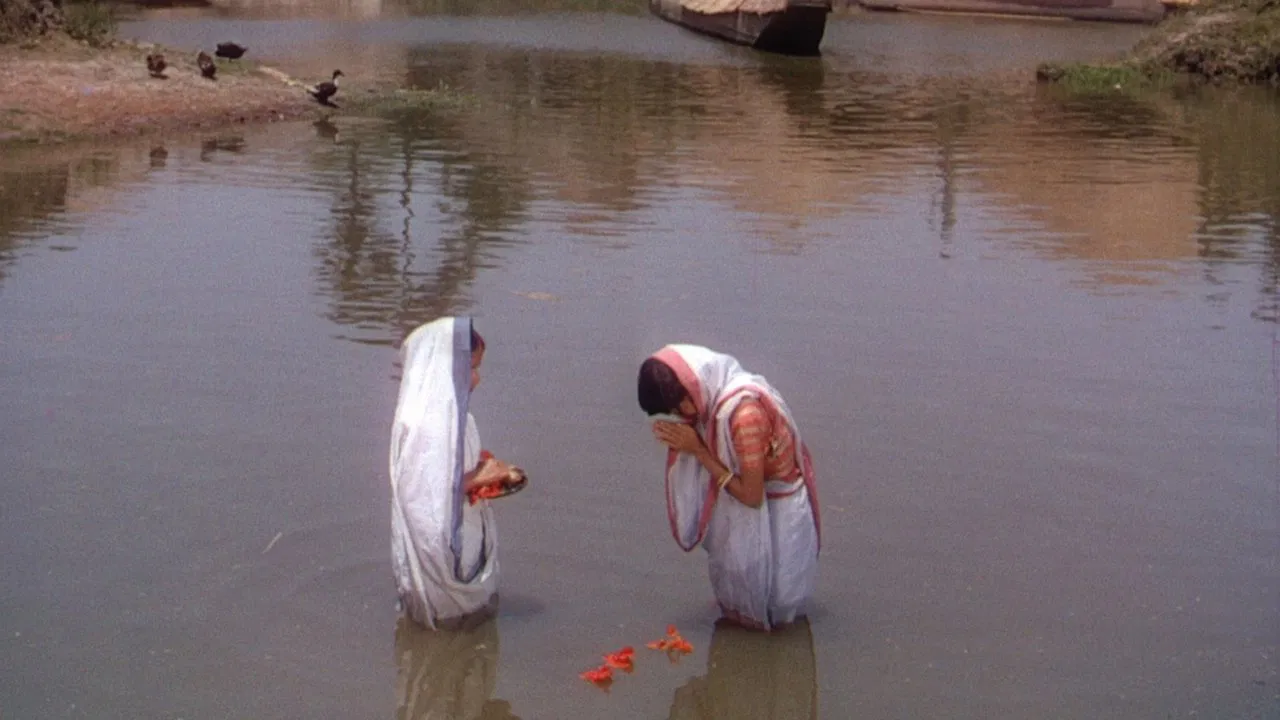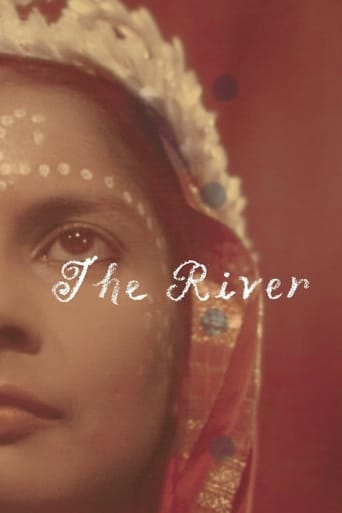

Three adolescent girls growing up in Bengal, India, learn their lessons in life after falling for an older American soldier.While I am not at all familiar with the cinema of India, my impression is that it probably did not get started until the 1960s. Maybe this is wrong. But Jean Renoir's "River" may be the first significant film to come out of India following the country's independence in 1948.The "coming of age" aspect of the three girls is very interesting and a good narrative, but more important is the way Indian culture and religion is shown. When did the West become interested in India? Long ago, surely. But there seems to be a Renaissance mid-1900s with such writers as Christopher Isherwood. This film, no doubt, helped push that Renaissance.
... View MoreIn Bengal, India, the teenager Harriet (Patricia Walters) is the oldest daughter of a British family composed by her father (Esmond Knight) that lost one eye in the war and is the manager of a jute factory; her mother (Nora Swinburne) that is pregnant; and her four younger sisters and one little brother. They have a quiet and comfortable life living in a big house nearby the Ganges River. Valerie (Adrienne Corri) is the teenage daughter the owner of the jute factory where Harriet's father works that spends most of her time with Harriet. Melanie is the British-Indian daughter of Harriet's neighbor Mr. John (Arthur Shields) that has just returned from an education in England. When the young American Captain John (Thomas E. Breen) that lost one of his legs in the war comes to Bengal to visit his cousin Mr. John, the three teenagers fall in love for him. "The River" is a story of first love in the exotic India and metaphorically compares the Ganges River with the flow of life with the lead character leaving her childhood and becoming an adolescent. The screenplay of this romance has many beautiful quotes, but excessive narrative from a grown-up Harriet. The cinematography is stunning, with the use of bright colors in the environment of India. Thomas E. Breen performs an outcast character that has a great complex due to the loss of one of his legs but he does not transmit this feeling to the audience. The red-haired Adrienne Corri is a very beautiful young woman that gives credibility to her sixteen year-old character. The Brazilian DVD was released by Continental Distributor. My vote is six.Title (Brazil): "O Rio Sagrado" ("The Sacred River")
... View MoreIn Jean Renoir's introduction to this film the great master cites Rumer Godden's book The River as the greatest work of literature about English colonialism in India. I can think of at least two books that are greater, E.M. Forster's A Passage to India, and George Orwell's Burmese Days, two works of literature which seem to indicate that Britain's endeavors in India produced more harm than a few damaged human relations among the English.Never the less, Jean Renoir brings unbelievable beauty to this film, which was his first attempt at full Technicolor, and it's a glorious attempt, called the most beautiful color film (along with Powell and Pressburger's The Red Shoes) by Martin Scorsese.The color has a warm subtlety and grace which can only be described as characteristic as his father's paintings, cheap as that sounds.Is The River the Rules of the Game of Renoir's color period, as Andre Bazin claims? No, I'm afraid no movie is as good as The Rules of the Game, yet this is a wonderful and important work all the same.
... View MoreThe River is, understandably, very high on top of film-buffs' lists of favorite Jean Renoir films. It's also a picture that needs a little patience on some more modern viewers' parts- it's more meditative than it looks at first, and despite the narration from adult Harriet (taken, I would guess, verbatim from Rumer Godden's original semi-autobiographic novel) coming off every now and again as slightly padded to certain moments that should be without a word spoke, it takes the nature of the environment, the locations, the people, the culture, the spirituality, all at a simple subjective viewpoint. Which, in a way, makes it more powerful than it would be had it been put through some kind of filter of a native. Renoir knows that he's a foreigner, and that Godden was as well, so that it's at times almost anthropological in the side glances at the Indian life along the river. Through this perspective, and in the framework of a 'coming-of-age' story, is a warm, mostly innocent film of love and life.It would be one thing to try and deconstruct the performances- it would take too long than is allotted on this site. Suffice to say Renoir does much with a cast that have either acted mostly in character-acting parts, or (in the case of real life one-legged Captain John played by Thomas Breen) not much at all. Even from an actress like Patricia Walters, who under a less careful attention to detail would seem as spoiled, or petty and intolerable, as a Veruca Salt, in Harriet there's a tenderness there when she has her heart broken over and over again as she watched John fall into the arms of Valerie. I especially liked how she stayed true to that sense of bewilderment, disillusionment that has to come at that age when concerning the passing of life (the tragic death of her younger brother, the truest innocent in the film), and what it means to really love and love back. She might still seem all frustrated and confused in that final scene in the boat with John, but it works nonetheless at the emotional side. Other actors like Suprova Mukerjee (her only significant performance in a film) and Radha, with her sad eyes, also contribute heavily. Only Nora Swinburne feels like a 'conventional' English matriarchal presence, though not as a 'bad' thing to the story.What should likely be discussed more than anything are the visuals, the look, the style, the carefully ritualistic world that the people along the river contribute and take away from and how they're depicted. Renoir, as has been written, didn't want to put any of the usual Hollywood stereotypes of tigers and elephants and such in the picture- his reverence also contributes to the meditative quality, how there's at times documentary qualities to how the narration goes over the movements of the river scenes. And maybe the most daring scene being the unbroken take of the dance in Harriet's story, where the woman has to be in-line with the camera-work (as Scorsese, major fan of the film, noted on the DVD, there's no dolly for Renoir), and never misses a step to the exquisite beat of the music. Any other director might go in for the close-up, or go back to a long-shot for a master, but here it's like a scene in Singin in the Rain: we're privy to every step, as the length of the shot becomes part of the dance, of (not to sound pretentious) the communication of it. I don't even listen to much Indian music or watch the dances, but it's spellbinding in the case of the River.And, along with The Wizard of Oz, some of Powell and Pressburger's late 40s work, and Johnny Guitar, it's one of the most superb Technicolor films of the period. As many a modern viewer will not take into account (I wouldn't of had I not gone to an art museum lately), Renoir is the son of one of the great painters (forget impressionist, just in general), and it's to this that one can see pitch, brightness, the depth and scope of a palette used to its fullest. It could be argued that The River isn't a masterpiece in terms of the story or characters, but I'd hate to be with the one who'd argue about how the color doesn't work or doesn't sit well. Aside from the painterly compositions, it's just a very pleasant film to look at, and it would be for this reason I would seek it out if it plays on a revival screen in New York City or other. 9.5/10
... View More